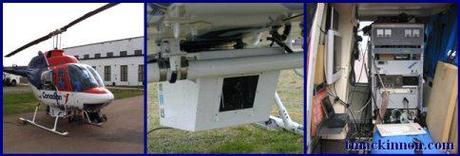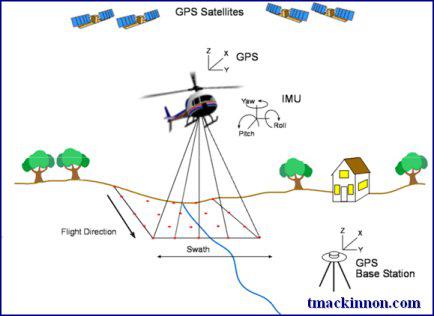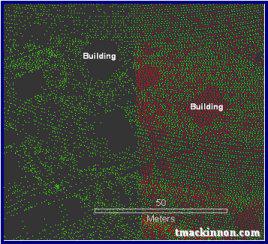
LIDAR has become a major portion of my geomatics career and was the main focus of my graduate research projectthat I completed at the Applied Geomatics Research Group (AGRG) and the Centre of Geographic Sciences (COGS) in Nova Scotia. The data that I processed and products that I generated while at the AGRG are helping Environment Canada and other Government Organizations to create adaptation strategies to coastal flooding problems in the Maritime Provinces. This section of my site is meant to provide a brief understanding of LIDAR technology while demonstrating some of the highlights of my graduate work and other LIDAR projects that I have been involved with.

Basic overview of LIDAR
Most LIDAR units are airborne types, so this next statement refers mainly to that type of LIDAR but I will also later on go into detail about Terrestrial LIDAR scanning as well. The LIDAR unit uses a high precision Global Position System (GPS) and an Inertial Measurement Unit (IMU) to determine the location and measure the attitude of the aircraft so that the ground location of the return pulse can be accurately determined. The LIDAR sensor produces a series of point measurements that consists of geographic location (X & Y) and height (Z) of both natural and man-made features, and can be further processed to produce several different products and integrated into a Geographic Information System (GIS).

Data produced from a LIDAR sensor in its most common form, is often represented by a series of spatial coordinates (or a 3D point cloud) in an American Standard Code for Information Interchange file (ASCII), or LAS file format. The LAS file format is a public file format for the interchange of LIDAR data between vendors and customers. This binary file format is an alternative to proprietary systems or the generic ASCII file interchange system used by many companies.
The data in the file is recorded in a tabular format where each line has coordinate information separated by a common delimiter. The data can include other attribute information for each point as well. There are additional ways to represent LIDAR data such as LAS format, which is an alternative to the generic ASCII file format used by many companies.
Resultant LIDAR data is usually a very dense network of coordinate points and can often contain millions of measurements for a given area. This can result into large file sizes, depending on the collection area and data resolution, which has been known to be difficult to handle with the majority of common off the shelf software packages. Continue to my 2004 LIDAR research project.
LIDAR LINKS
- 2004 LiDAR Industry Directory
- The Lowdown on LIDAR, by Robert A. Fowler, EOM Archives
- LIDAR for Flood Mapping, by Robert A. Fowler, EOM Current Issues
- Imaging Laser Altimetry
- Find Jobs in LIDAR
Find out more about LIDAR and check out some of my LIDAR work

